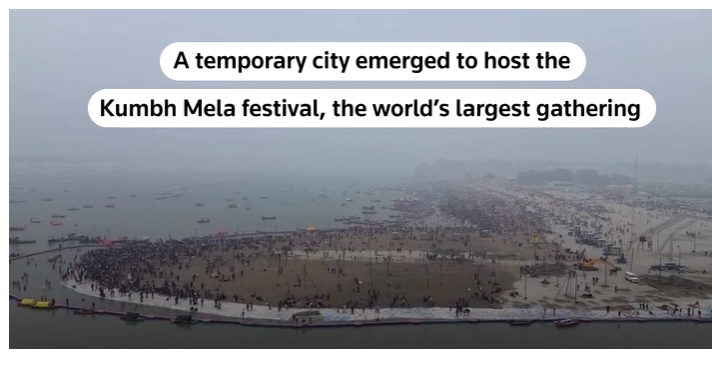Maha Kumbh Mela 2025

Maha Kumbh Mela 2025
- Event Overview: Maha Kumbh Mela 2025, held in Prayagraj, Uttar Pradesh, is the world’s largest religious gathering, expected to host over 400 million visitors over six weeks. It is a Hindu festival where devotees take a holy dip in the confluence of Ganga, Yamuna, and the mythical Saraswati rivers.
- Religious Significance: The festival is rooted in Hindu mythology, linked to the legend of Vishnu retrieving the nectar of immortality. The "maha" prefix denotes greater auspiciousness, occurring once every 12 years in the rotational Kumbh cycle (Prayagraj, Haridwar, Ujjain, Nashik). The event holds spiritual significance, promising absolution of sins and liberation from the cycle of life and death.
- Infrastructure & Logistics:
- A temporary city covering 4,000 hectares was set up with 150,000 tents, 145,000 restrooms, 3,000 kitchens, 99 parking lots, and up to 450,000 new electricity connections.
- Indian Railways deployed 98 special trains making 3,300 trips to transport pilgrims.
- Security arrangements include 40,000 police personnel and AI-powered surveillance, along with 125 road ambulances, seven river ambulances, and air ambulances.
- Economic & Tourism Impact: The event is a significant driver of tourism in Uttar Pradesh, contributing to local employment in hospitality, transport, and ancillary services. The state allocated ₹64 billion ($765 million) for the event and promoted it internationally.
- Governance & Crowd Management: The festival serves as a litmus test for India’s administrative capacity in handling mass gatherings while maintaining safety and public order. Coordination between multiple agencies (police, disaster management, health services) is crucial.
- Political Dimension: Maha Kumbh also has political undertones. It reinforces the cultural and religious symbolism emphasized by the ruling BJP government under PM Modi and CM Yogi Adityanath. The event is used to showcase governance efficiency and cultural leadership domestically and internationally.
Updated - January 13, 2025 ; 12: 29 PM | Reuters
Prayagraj Uttar Pradesh Hindu Festival World’s Largest Gathering Religious Tourism Pilgrimage Ganga-Yamuna-Saraswati Confluence Temporary City Crowd Management AI Surveillance Indian Railways Special Trains Disaster Management Public Safety Government Expenditure Cultural Heritage BJP Yogi Adityanath PM Modi Indian Tourism GS Paper 1 GS Paper 3 Current Affairs Mass Gatherings Spiritual Significance Pilgrim Infrastructure Administrative Capacity Economic Impact